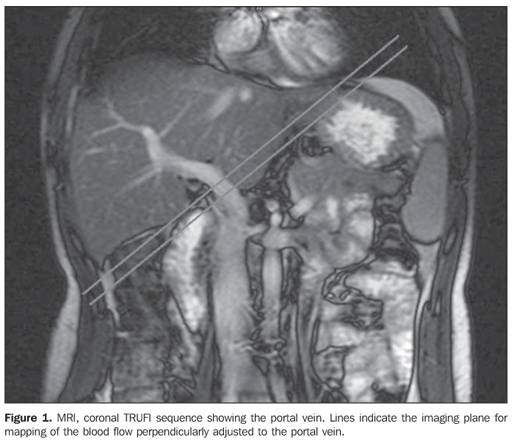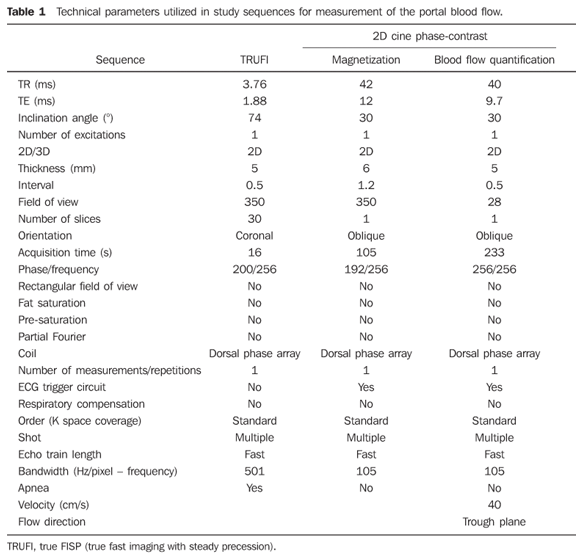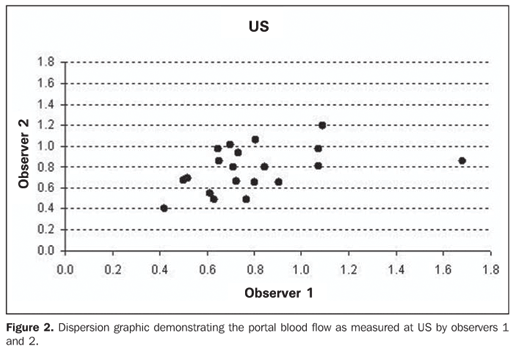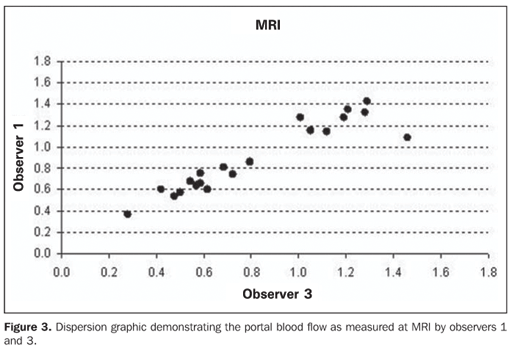Radiologia Brasileira - Publicação Científica Oficial do Colégio Brasileiro de Radiologia
AMB - Associação Médica Brasileira CNA - Comissão Nacional de Acreditação
 Vol. 41 nº 4 - July / Aug. of 2008
Vol. 41 nº 4 - July / Aug. of 2008
|
ORIGINAL ARTICLE
|
|
Measurement of portal blood flow in healthy individuals: a comparison between magnetic resonance imaging and Doppler ultrasound |
|
|
Autho(rs): Juliana Dantas da Costa, Alberto Ribeiro de Souza Leão, José Eduardo Mourão Santos, Danilo Sales Moulin, Patrícia Moreno Sebastianes, Giuseppe D'Ippolito |
|
|
Keywords: Portal blood flow, Magnetic resonance imaging, Ultrasonography |
|
|
Abstract:
IMDs, Residents, Department of Imaging Diagnosis, Universidade Federal de São Paulo/Escola Paulista de Medicina (Unifesp/EPM), São Paulo, SP, Brazil
INTRODUCTION Portal hypertension is a hemodynamic disorder characterized by persistent increase in the venous pressure in the portal system, clinically translated into collateral circulation and ascites. This is a frequent and severe complication of several chronic hepatopathies(1). Portal hypertension is a result from a relative or absolute obstruction of the splanchnic blood flow or, most rarely, from an increase in the portal blood flow, and is defined when the pressure measured in the hepatic vein or directly in the portal vein is > 5 mmHg than the inferior vena cava (i.e., a portosystemic gradient > 5 mmHg) or the pressure in the splenic vein is higher than 15 mmHg. However, direct measurement or reference standard determination can only be performed by means of invasive methods(2–4). Ultrasonography (US) in association with color-Doppler represents the primary method for evaluating the portal system and portal hypertension(5–8). Among the several measurable parameters, the portal blood flow measured by Doppler-US has been utilized for predicting the response to treatment in patients with portal hypertension(9). The evaluation of the portal vein caliber, its alteration with the inspiration and expiration, flow velocity and direction, as well as volume measured in the portal vein and presence of collateral circulation are other parameters considered in the characterization of portal hypertension(7,10,11). Ready availability, relatively short procedure time and low cost may be mentioned as the main advantages of Doppler-US(2). However, this method is susceptible to errors, presenting variations in the measurements in the region of the portal vein, determination of the mean blood flow velocity and insonation angle utilized in the portal vein evaluation, besides technical limitations related to obesity, intestinal meteorism, non-collaborative patients, ascites and decrease in the liver volume(6,7,12–16). These limitations may lead to the utilization of other more accurate diagnostic methods, such as magnetic resonance imaging (MRI). MRI angiography, for example, allows the evaluation of the blood flow within the vessel without the Doppler-US inconveniences(2); however it is highly expensive and is not widely available. Several studies have demonstrated that the mapping of the blood flow velocity by PCA MRI is a non-invasive method with good reproducibility in the quantitative measurement of the portal venous system blood flow of both healthy individuals and patients with portal hypertension(14,17–20) during normal respiration which would be considered as the most physiological situation for this study(16,17,21). However, these studies have been developed with obsolete equipment in low magnetic field and with outdated techniques, besides not evaluating the MRI reproducibility (interobserver agreement). The reproducibility of a diagnostic method measures its accuracy and is essential for validating the usefulness of this method in the clinical practice. Notwithstanding the wealthy of studies demonstrating the Doppler US reproducibility in the evaluation of the portal blood flow(2,10, 12,13,17–19), there is a lack of studies utilizing MRI for the same purpose and comparing both methods in a same group of healthy individuals, with current techniques and equipment. The present study is aimed at evaluating the intermethod (Doppler US and MRI) agreement in the measurement of the portal blood flow in healthy individuals, as well as the reproducibility of these diagnostic methods.
MATERIALS AND METHODS A prospective, transverse, observational, double-blinded and self-paired study was developed with 20 healthy volunteers submitted to color Doppler US and MRI in the Department of Imaging Diagnosis at Universidade Federal de São Paulo/Escola Paulista de Medicina (Unifesp/EPM), São Paulo, SP, Brazil, in the period between August 2006 and June 2007. The study was approved by the Committee for Ethics in Research of the institution and all of the volunteers signed a term of free and informed consent. Individuals selection Twenty volunteers — 15 men and five women, in the age range between 25 and 39 years (mean = 29.1 years) — participated in the present study. They were considered as healthy for being asymptomatic, denying previous history of alcoholism (ingestion of more than 160 g of ethanol per week), with negative serology for hepatitis B and C viruses, and no previous history of proved autoimmune disease that might course with autoimmune hepatitis, denying use of hepatotoxic drugs, and originating from areas endemic for schistosomiasis. Additionally, all of them denied possible contraindications for MRI such as cardiac pacemaker, cochlear implant or claustrophobia. US and MRI examinations were performed at up to 15-day intervals and preferably at the same day. All of the patients were examined after four to six-hour fasting. Doppler US studies US examinations were blindly and independently performed by two observers in an EnVisorTM equipment (Philips Medical Systems; Washington, USA) with a multifrequency, convex transducer, utilizing slices/planes in compliance with the World Health Organization standards for sonographic evaluation of the liver, spleen and splenic vascular system. The portal vein Doppler study was performed with the patient in dorsal decubitus, after a short rest period, with subcostal and oblique intercostal views of the portal vein trunk at a half-distance from the bifurcation, in the same respiratory phase, and with an insonation angle ranging between 45º and 60º. Caliber and area of the portal vein were measured on the same topography of the dopplerfluxometric sampling for the flow calculation. Following the spectral curve acquisition, a sample of at least four seconds was obtained for measurement of the portal vein diameter which was utilized by the software package of the US equipment for calculating the vessel section area. The value for mean flow velocity was measured by the equipment itself in the selected interval, finally providing the mean flow in the segment evaluated during this period. MRI angiography studies MRI angiography studies were performed in a Magnetom SymphonyTM (Siemens; Erlangen, Germany) equipment operating in a high magnetic field (1.5 tesla), with a phased-array body coil. Portal vein localization was determined by coronal true fast imaging with steady precession (TRUFI) sequences. The imaging plane for blood flow mapping was adjusted perpendicularly to the portal vein (Figure 1) and the phase-contrast technique was utilized for images acquisition. The parameters utilized are shown on Table 1.
Two independent observers with more than three years of experience in Doppler US and abdominal MRI after completing medical residency in imaging diagnosis and specific training for portal blood flow measurement by both methods performed and evaluated all the US Doppler and MRI studies. Interobserver agreement for each of the methods was evaluated by calculating the intraclass correlation coefficient and respective confidence interval at 95% (IC 95%). The classification proposed by Fleiss(22) was utilized for interpreting the results, as shown on Table 2. Also, the Pearson's correlation coefficient was utilized for calculating the linearity degree between measurements obtained by the two observers.
The same patients had their portal blood flow evaluated at US by two independent observers (observer 1 and observer 2). These same portal blood flows at MRI were also evaluated by other two observers, one of them being the same who had performed the US examinations (observer 1 and observer 3). The analysis of agreement between US Doppler and MRI measurements performed by the observer 1 was ruled out to avoid any bias. Also, the mean value for the portal blood flow measured by the observers was calculated for each study. The significance level of 5% (a = 0.05) was adopted for the whole statistical analysis, that is to say that results corresponding to a p value lower than 5% (p < 0.05) were considered as statistically significant.
RESULTS The US reproducibility in the evaluation of the portal blood flow demonstrated a merely regular interobserver agreement (intraclass correlation coefficient: 43.3%; Pearson's correlation coefficient: 43.0%). Figure 2 presents a dispersion graphic with values for portal flow obtained by these two observers, where data seem not approximating a straight line.
As regards the MRI reproducibility in the evaluation of the portal blood flow, a good interobserver agreement was observed (intraclass correlation coefficient: 91.4%; Pearson's correlation coefficient: 93.4%). Figure 3 presents a dispersion graphic with values for portal flow obtained by these two observers, where data seem to approximate a straight line, i.e., data regarding the portal blood flow obtained by the two observers are positively correlated (p < 0.001).
A low intermethod agreement was observed in the evaluation of MRI and US results (depending on the observers, the intraclass correlation coefficient ranged between 1.9% and 18.2%, and the Pearson's correlation coefficient, between 0.1% and 13.7%; p = 0.565). Notwithstanding, mean values for portal blood flow found a US and MRI were similar, respectively corresponding to 0.768 l/min (IC 95%: 0.401;1.270) and 0.742 l/min (IC 95%: 0.326;1.355).
DISCUSSION Morphological and hemodynamic studies in cases of portal hypertension play a significant role in the attempt to better understand a clinical condition that frequently leads to severe complications, for example, high digestive hemorrhage(23). For this reason, the imaging evaluation of the portal system for quantifying the portal venous flow and analyzing the hemodynamics of this venous system in patients with chronic hepatopathy is aimed at the early diagnosis of portal hypertension in a poorly symptomatic phase of the disease(23,24) and identifying cirrhotic or schistosomal patients with a higher risk for hemorrhage from esophageal varices(11,12,24). US is the method of choice in the evaluation of patients with portal hypertension because of its ready availability, excellent cost/benefit ratio and non-invasiveness. However, this method is susceptible to errors related to interobserver variability and the clinical conditions of the patient(6,7,12–16). The diagnostic accuracy of a method is an essential parameter for definition of it usefulness and can be determined by the evaluation of its reproducibility (or interobserver agreement). The present study demonstrated that the Doppler US reproducibility in the evaluation of the portal blood flow was merely regular and lower than the MRI reproducibility, coherently with the method limitations. Similar results have been found in previous studies approaching the role of Doppler US in the evaluation of patients with portal hypertension(25). The measurement of the blood flow by MRI is an objective technique for evaluating the portal blood flow. This method presents the advantages of providing spatial and temporal information on the blood flow in different phases of the cardiac cycle(18) and not requiring breath-hold acquisition, which could affect the hemodynamic parameters(13,14,21). Major MRI disadvantage is related to the cost of this method, besides the lesser availability and higher complexity for evaluating the images acquired. In the present study, a good interobserver agreement was found in the evaluation of the portal blood flow by MRI. However, no other study has been found in the literature about the reproducibility of this method in the evaluation of the portal blood flow in healthy individuals. It is important to note the poor intermethod agreement observed in the quantification of the portal blood flow by Doppler US and MRI. The higher MRI accuracy, and the fact of this method being considered as a reference standard in the evaluation of the blood flow lead to a tendency towards considering the results of this method as the closest to the actual values(2,13,14,16,26). Further studies with larger samples and utilizing specific phantoms are necessary to validate the results of the present study. Similarly to the results of the present study, mean values for the portal blood flow in healthy individuals at MRI in previous studies have presented a high variability, ranging from 0.5 l/min to 1.3 l/min(14,17,18). On the other hand, few studies were found in the literature with mean values for portal blood flow measured by Doppler US in healthy individuals. Differently from the present study, Kashitani et al.(6) have found and average of 1.25 l/min. Lycklama à Nijeholt et al.(18) have also reported mean values for the blood flow in the portal branches at Doppler US ranging from 0.578 l/min to 0.606 l/min, which approximate the measurements found in the present study in the portal vein trunk. It is important to note, in the present study, the high variability in normal values of measurements by US (0.41 l/min to 1.27 l/min) and MRI (0.32 l/min to 1.32 l/min) in asymptomatic patients, suggesting a high variability in the standard portal flow or, otherwise, poor reliability of measurements. The results of the present study were based on the evaluation of a limited population of asymptomatic volunteers, with a limited presumed variability. Notwithstanding, a high variation was observed in normal values, which does not allow an approach in terms of normality interval. Further studies with larger samples will be necessary for determining a narrower range of normality values.
CONCLUSION The present study demonstrated that phase-contrast MRI presents an excellent reproducibility and is superior to Doppler US in the measurement of the portal blood flow. On the other hand, the intermethod agreement is low, and the authors could not determine a reliable interval corresponding to normality values for the portal blood flow. Further studies will be necessary for determining the value of these methods.
REFERENCES 1. Mincis M. Gastroenterologia e hepatologia – diagnóstico e tratamento. 3ª ed. São Paulo: Lemos Editorial; 2002. [ ] 2. Pieters PC, Miller WJ, DeMeo JH. Evaluation of the portal venous system: complementary roles of invasive and noninvasive imaging strategies. Radiographics. 1997;17:879–95. [ ] 3. Alves Jr A, Fontes DA, Melo VA, et al. Hipertensão portal esquistossomótica: influência do fluxo sangüíneo portal nos níveis séricos das enzimas hepáticas Arq Gastroenterol. 2003;40:203–8. [ ] 4. Iida VH, Silva TJA, Silva ASF, et al. Cirrose hepática: aspectos morfológicos relacionados às suas possíveis complicações. Um estudo centrado em necropsias. J Bras Patol Med Lab. 2005;41: 29–36. [ ] 5. O'Donohue J, Ng C, Catnach S, et al. Diagnostic value of Doppler assessment of the hepatic and portal vessels and ultrasound of the spleen in liver disease. Eur J Gastroenterol Hepatol. 2004;16: 147–55. [ ] 6. Kashitani N, Kimoto S, Tsunoda M, et al. Portal blood flow in the presence or absence of diffuse liver disease: measurement by phase contrast MR imaging. Abdom Imaging. 1995;20:197–200. [ ] 7. Machado MM, Rosa ACF, Barros N, et al. Estudo Doppler na hipertensão portal. Radiol Bras. 2004;37:35–9. [ ] 8. Silva LC, Lima AS, Tavares Júnior WC, et al. Evidências de hiperfluxo portal no pós-operatório de transplantes hepáticos. Radiol Bras. 2005; 38:261–4. [ ] 9. Harrod-Kim P, Waldman DL. Abnormal portal venous flow at sonography predicts reduced survival after transjugular intrahepatic portosystemic shunt creation. J Vasc Interv Radiol. 2005;16: 1459–64. [ ] 10. Vezozzo DCP, Rocha DC, Cerri GG. Fígado. In: Cerri GG, Rocha DC, editores. Ultra-sonografia abdominal. São Paulo: Sarvier; 1993. p. 61–90. [ ] 11. Machado MM, Rosa ACF, Mota OM, et al. Aspectos ultra-sonográficos da trombose da veia porta. Radiol Bras. 2006;39:151–5. [ ] 12. Sabba C, Merkel C, Zoli M, et al. Interobserver and interequipment variability of echo-Doppler examination of the portal vein: effect of a cooperative training program. Hepatology. 1995;21: 428–33. [ ] 13. Annet L, Materne R, Danse E, et al. Hepatic flow parameters measured with MR imaging and Doppler US: correlations with degree of cirrhosis and portal hypertension. Radiology. 2003;229:409–14. [ ] 14. Burkart DJ, Johnson CD, Morton MJ, et al. Volumetric flow rates in the portal venous system: measurement with cine phase-contrast MR imaging. AJR Am J Roentgenol. 1993;160:1113–8. [ ] 15. Winkfield B, Aubé C, Burtin P, et al. Inter-observer and intra-observer variability in hepatology. Eur J Gastroenterol Hepatol. 2003;15:959–66. [ ] 16. Tsunoda M, Kimoto S, Hamazaki K, et al. Quantitative measurement of portal blood flow by magnetic resonance phase contrast: comparative study of flow phantom and Doppler ultrasound in vivo. Acta Med Okayama. 1994;48:283–8. [ ] 17. Sugano S, Yamamoto K, Sasao K, et al. Portal venous flow while breath-holding after inspiration or expiration and during normal respiration in controls and cirrhotics. J Gastroenterol. 1999; 34:613–8. [ ] 18. Lycklama à Nijeholt GJ, Burggraaf K, Wasser MNJM, et al. Variability of splanchnic blood flow measurements using MR velocity mapping under fasting and post-prandial conditions – comparison with echo-Doppler. J Hepatol. 1997;26:298–304. [ ] 19. Tamada T, Moriyasu F, Ono S, et al. Portal blood flow: measurement with MR imaging. Radiology. 1989;173:639–44. [ ] 20. Edelman RR, Zhao B, Liu C, et al. MR angiography and dynamic flow evaluation of the portal venous system. AJR Am J Roentgenol. 1989;153: 755–60. [ ] 21. Caldana RP, Bezerra ASA, Soares AFF, et al. Angiografia por ressonância magnética: aspectos técnicos de um método de estudo vascular não-invasivo. Radiol Bras. 2004;37:41–50. [ ] 22. Fleiss JL. Statistical methods for rates and proportions. 2nd ed. New York: Wiley; 1981. [ ] 23. Bolondi L, Gandolfi L, Arienti V, et al. Ultrasonography in the diagnosis of portal hypertension: diminished response of portal vessels to respiration. Radiology. 1982;142:167–72. [ ] 24. Martins RD, Szejnfeld J, Lima FG, et al. Endoscopic, ultrasonographic, and US-Doppler parameters as indicators of variceal bleeding in patients with schistosomiasis. Dig Dis Sci. 2000;45: 1013–8. [ ] 25. Bezerra ASA, D'Ippolito G, Caldana RP, et al. Avaliação hepática e esplênica por ressonância magnética em pacientes portadores de esquistossomose mansônica crônica. Radiol Bras. 2004; 37:313–21. [ ] 26. Caldana RP, Bezerra ASA, D'Ippolito G, et al. Estudo da circulação hepatomesentérica pela angiografia por ressonância magnética com gadolínio: comparação entre doses simples e dupla no estudo de pacientes esquistossomóticos. Radiol Bras. 2006;39:243–51. [ ] Received August 24, 2007. Accepted after revision October 23, 2007. * Study developed in the Department of Imaging Diagnosis, Universidade Federal de São Paulo/Escola Paulista de Medicina (Unifesp/EPM), São Paulo, SP, Brazil. |
|
Av. Paulista, 37 - 7° andar - Conj. 71 - CEP 01311-902 - São Paulo - SP - Brazil - Phone: (11) 3372-4544 - Fax: (11) 3372-4554





